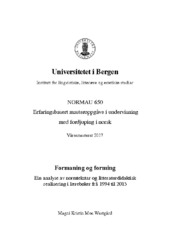| dc.contributor.author | Westgård, Magni Kristin Moe | |
| dc.date.accessioned | 2017-06-16T06:47:13Z | |
| dc.date.available | 2017-06-16T06:47:13Z | |
| dc.date.issued | 2017-06-15 | |
| dc.date.submitted | 2017-06-14T22:00:08Z | |
| dc.identifier.uri | https://hdl.handle.net/1956/15996 | |
| dc.description.abstract | Eitt mål for dette arbeidet har vore å undersøkje korleis diskursen omkring skjønnlitteratur i norskfaget har endra seg frå læreplanverket som kom i 1994 (R94) og til den reviderte versjonen av Kunnskapsløftet som vart gjort gjeldande i 2013. Eit anna mål har vore å sjå i kor stor grad føringane frå normtekstane har gjort seg gjeldande i lærebøker. Problemformuleringa var: Kva for ideologisk utvikling kan ein finne i norsk læreplandiskurs frå 1994 fram til gjeldande plan, og korleis har normtekstane påverka den skjønnlitterære diskursen i eit utval lærebøker? For å operasjonalisere arbeidet, har eg hatt desse forskingsspørsmåla: 1) Korleis kan ein argumentere for litteraturen i skulen? 2) Korleis har danningsdiskursen endra seg i læreplanar frå 90-talet og fram til gjeldande norskplan? 3) Kva for litteratursyn og danningsdiskurs kjem til uttrykk i lærebøker frå ulike læreplanregimer? 4) Kva for litteraturkompetanse skal ein elev i den vidaregåande skulen ha i 2017 samanlikna med 1994? Oppgåva inneheld ein kvalitativ diskursanalyse av normtekstar sett opp mot fagdidaktisk realisering i arbeidsoppgåvene til eit utval litterære tekstar i fire læreverk. Læreverket Kolon og Grunnlinjer/Tekstlinjer vart produsert etter Reform 94. Intertekst og Grip teksten kom etter revisjonen av Kunnskapsløftet i 2013. I tillegg har det vore eit poeng å gjere ei diakron samanlikning av kva forfattarar, tekstar og sjangrar elevane i den vidaregåande skulen har fått tilgang til gjennom antologiane i læreverka. Med utgangspunkt i Wolfgang Klafki sine danningsteoriar, er det er knytt ulike danningsdefinisjonar til analysen. I tillegg er det brukt ulike litteraturdidaktiske diskursar, definert av Pål Hamre og Laila Aase. Undersøkinga peiker i retning av to hovudtendensar. Det eine er at normtekstane ber tydeleg preg av ulike ideologiske føringar. Arbeidarparti-statsråd Gudmund Hernes, som leia arbeidet med læreplanane på 90-talet, la for dagen eit materialt danningssyn, der nasjonsbyggingsdiskursen var tydeleg. Han la vekt på dei kollektive verdiane og la opp til sterk statleg styring. Høgre-statsråd Kristin Clemet var entreprenør for Kunnskapsløftet som vart gjort gjeldande i 2006 og revidert i 2013. I denne planen er det formale danningssynet tydeleg, og undervisarane får større fridom. Dei prosessane elevane skal gjennom er synlege og målbare i ein instrumentell diskurs. Det andre funnet er at den skjønnlitterære diskursen i lærebøkene blir påverka mindre enn normtekstane skulle tilseie. | en_US |
| dc.description.abstract | The purpose of the work for this thesis was to analyse how discourse concerning literary works has changed in recent curriculum revisions in the subject “Norwegian Language and Literature” at the upper secondary education level in Norway. The curriculum approved in 1994 was compared to the current curriculum, which was introduced in 2006 and revised in 2013. The primary objective has been to investigate the ideological development of the national curriculums, and how regulations have affected the literary discourse in a selection of textbooks used in school. The main questions addressed in this research were 1) how literature is advocated in upper secondary school, 2) how the discourse concerning personal development changed in the two curriculum periods, 3) how textbook authors present literature instruction within the different curriculums, and 4) what the literary competency for upper secondary school pupils today should be, compared to that in 1994. This work is a qualitative discourse analysis of the intentions of the regulatory texts, compared to the didactic principles which appear in the tasks formulated for literary texts in four different textbooks for the subject “Norwegian Language and Literature”. The textbook Kolon and Grunnlinjer/Tekstlinjer were produced based on the curriculum regulation in 1994. Intertekst and Grip teksten came after the revision of Kunnskapsløftet in 2013. In addition to this qualitative analysis, a diachronic analysis was done based on which authors, literary texts and genres pupils have had access to through the anthologies. The analyses used German educator Wolfgang Klafki’s educative categories: material, formal and critically-oriented educations. The discourse categories defined by Pål Hamre and Laila Aase were also employed. The research presented points out two major findings. The first finding is that the ideology behind each of the curriculums is readily apparent. The social democratic Minister of Education Gudmund Hernes, who formed the curriculums in the nineties, focused on a material-oriented education, and the discourse of nation-building is consistent. The curriculum developed during this time shows a strong desire for state-control of learning activities. «Kunnskapsløftet» was carried out by the conservative Minister of Education Kristin Clemet in 2006 and revised in 2013. This regulative shows a greater focus on the formal oriented education, and the instrumental discourse is visible throughout the text. In this most recent curriculum, educators have more individual freedom than the curriculum from 1994. The second finding of the research presented is that the textbooks are much more conservative in their incorporation of the curriculum regulations. | en_US |
| dc.language.iso | nno | eng |
| dc.publisher | The University of Bergen | eng |
| dc.title | Formaning og forming. Ein analyse av normtekstar og litteraturdidaktisk realisering i lærebøker frå 1994 til 2015 | eng |
| dc.type | Master thesis | |
| dc.date.updated | 2017-06-14T22:00:08Z | |
| dc.rights.holder | Copyright the Author. All rights reserved | eng |
| dc.description.degree | Erfaringsbasert masteroppgåve i undervisning med fordjupning i norsk | |
| dc.description.localcode | VID-MAUNOR | |
| dc.description.localcode | NORMAU650 | |
| dc.subject.nus | 711123 | eng |
| fs.subjectcode | NORMAU650 | |
| fs.unitcode | 11-21-00 | |

